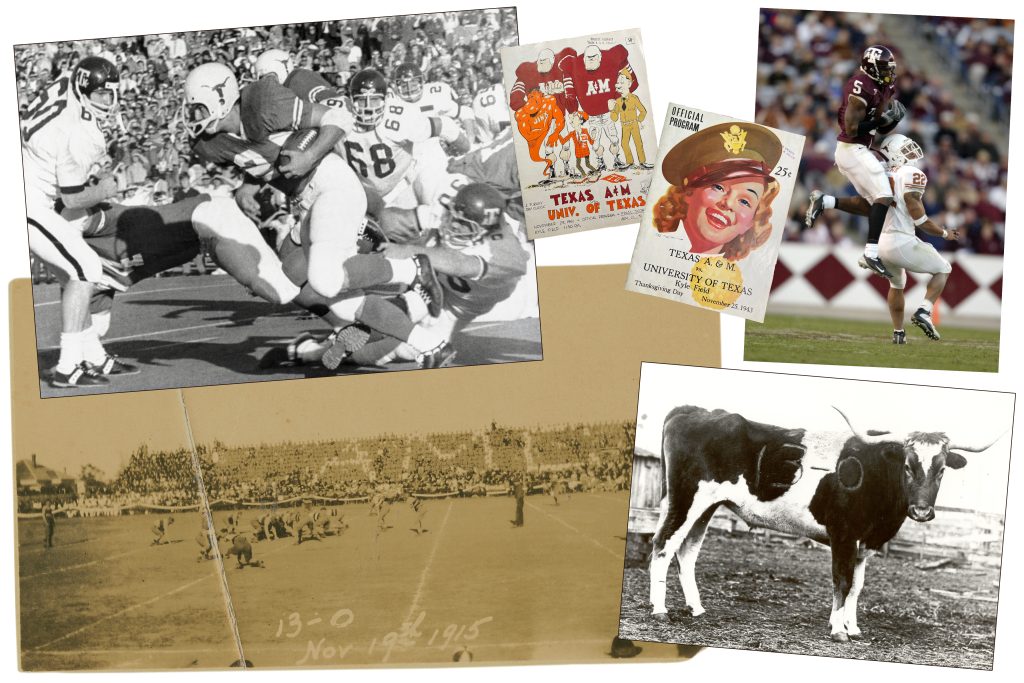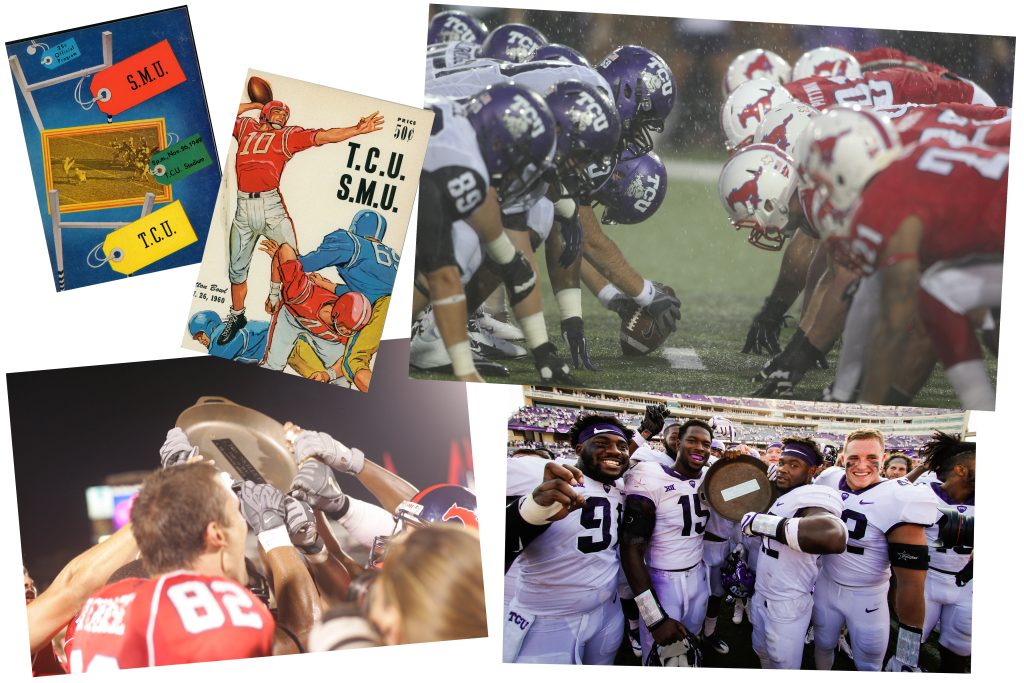Feud-Ball: The Two Most Iconic Rivalries in Texas
Texas is famous for its rivalries. From disputes between Dallas and Fort Worth to chili cook-offs in Terlingua to barbecue feuds in Lockhart, competition is just part of Texas culture. But there’s no rivalry so embittered — and so entertaining — than one that’s duked out on a college football field.
Here are the stories of the two most iconic football rivalries in Texas, both of which date back more than 100 years. It’s been Aggies vs. Longhorns and Mustangs vs. Horned Frogs ever since.

The Lone Star Showdown
The most heated football rivalry in Texas has been boiling over between the University of Texas and Texas A&M since the 19th century. The two schools first met on the gridiron in Austin, way back in 1894, when UT’s Longhorns recorded their first W over the Aggies. By 1901, UT was not only dangling a seven- matchup win streak over A&M’s head but had also outscored them 157-0 — an ignominious start that set the stage for more than a century of mutual antagonism.
The Aggies snapped their losing (and scoreless) streak against the Longhorns in 1902, first with an unceremonious 0-0 tie in October and then with a glorious Thanksgiving win. It would be another seven years before A&M beat their Austin rivals again, but with that sweet victory in 1902, the Aggies proved they weren’t just a maroon punching bag. The scale had been tipped, stoking the rivalry hotter than ever.
A&M locked in their second win over UT in 1909, kicking off three decades when the two schools split their matchups almost exactly down the middle. Between then and 1939, the Longhorns took nearly every game against A&M at home (with just two losses in Austin, in 1909 and 1922), while the Aggies won all but three matchups versus UT in College Station (two of which were ties).
During this 30-year back-and-forth, the two universities’ enmity began to manifest fully in their respective cultures. In 1918, while sitting in a trench in France during the final months of World War I, an A&M student wrote the first draft of what would become the “Aggie War Hymn” — but that early version was titled “Goodbye to Texas University.” The lyrics were a direct provocation of the Longhorns, with lines such as “Goodbye to Texas University / So long to the orange and the white” still echoing around Kyle Field at College Station today.
It was only a matter of time before UT struck back with a new fight song of their own, “Texas Fight.” The lyrics, sung to a rapid-tempo rendition of military “Taps,” were intentionally written to ridicule and counteract the Aggie song. The very first words of the song are “Texas Fight, Texas Fight / And it’s goodbye to A&M” — words that first debuted in 1923 and haven’t disappeared since, even during games when the Longhorns are playing other schools.
The Aggies’ perfect 11-0 season and championship in the Southwest Conference in 1939 marked an end to the level playing field between the two foes. For the next 40 years, the annual Thanksgiving Day matchups between UT and A&M backslid into becoming largely Longhorn-dominated. The Aggies only won seven games against UT between 1940 and 1980, a dark period for the A&M faithful but a dazzlingly orange era for the Longhorns.
But in the 1984 season finale, the script was finally flipped when A&M beat UT 37-12 to prevent the Longhorns from winning the conference title. The win ignited a maroon decade, with the Aggies winning nine out of 10 games against UT. Aggie students were fortunate to be part of this generation — the Longhorns stormed back in 1995, returning to their supreme status and only giving up five games to A&M over the next 16 years.
The embittered feud came to an armistice in 2011 when Texas A&M truly said: “Goodbye to Texas University.” A&M announced it would be leaving the Big 12 Conference and joining the Southeastern Conference (SEC) starting in 2012. In a rare demonstration of unity, players, students, and alums from both schools expressed bittersweet dismay that such a hallmark rivalry in American college football should have to cease. But cease it did.
All told, the Longhorns and Aggies clashed 118 times between 1894 and 2011, with UT bragging a healthy lead in the series: 76 Longhorn wins, 37 Aggie wins, five ties.
But that’s not the end of the story; there’s hope yet for Aggies looking to even the score and for Longhorns hoping to pad their record. This year marks UT’s first season in the SEC, where their old nemesis, A&M, has been waiting for them. The much-anticipated match is set for Nov. 30, 2024, when orange and maroon uniforms will take to the gridiron in College Station for the first time in more than a decade to rekindle 130-year-old flames of rivalry.

The Battle of the Iron Skillet
The rivalry between the Southern Methodist University and Texas Christian University football squads might not be world-famous, but in North Texas, the tension is palpable. Dallas and Fort Worth have been quarreling neighbors for 150 years, so the annual matchup between SMU and TCU gives the two cities a good-sported outlet for any bad blood. The school that comes out on top gets more than just a year of bragging rights: They also win a cast-iron skillet-shaped trophy.
The Mustangs of SMU in Dallas have been locking helmets with TCU’s Horned Frogs in Fort Worth since 1915, but it wasn’t until sometime around 1946 that their annual grudge match first became known as the Iron Skillet game. Legend has it that during a tailgate outside the Mustangs’ Ownby Stadium, an SMU fan was pan-frying a pair of frog legs to goad the visiting Horned Frogs. When TCU fans saw their symbol desecrated, they made a bet that the winner of the game would get the pan.
SMU did win that day, so the home team kept the skillet and enjoyed their fried gams, much to TCU’s chagrin. But somehow or other, the bet was made an official tradition within the TCU-SMU rivalry, and ever since, the winning team has been presented with the coveted Iron Skillet trophy right on the field.
But the intercollegiate competition wasn’t always over a piece of cookware; sometimes, it was for all the marbles. Their most famous meeting was in 1935, when the Mustangs and the Horned Frogs met, each boasting perfect 10-0 records on the season. The event was dubbed “the game of the century” as it would crown the Southwest Conference champion and decide which team would become the first-ever SWC team to go to the Rose Bowl.
The buildup for the match was so intense that, when the day of the big game arrived, nearly 40,000 fans packed into Amon G. Carter Stadium in Fort Worth, an arena with only 30,000 seats.
The game lived up to all the hype. The Mustangs had a 14-0 lead until just before halftime, when TCU — led by All-American quarterback Sammy Baugh — thundered back with a 74-yard drive and touchdown to cut the deficit in half. In the fourth quarter, Baugh threw a passing touchdown to tie the game at 14, and the drama intensified with every passing second.
With less than 10 minutes on the clock, SMU pulled off a trick play: The Mustangs set up for a punt, but instead, quarterback Bob Finley made a 50-yard pass to connect with a receiver who fell into the end zone after catching the ball — putting the Mustangs up 20-14. After SMU missed their extra-point kick, Baugh and the Horned Frogs scrambled to rally back. With a handful of seconds left in the game and TCU just 35 yards from a game-tying TD, Baugh passed the ball to a receiver on the goal line. His pass was right on target, but a Mustang was too — the ball was swatted incomplete just as the clock hit 0:00.
With the win, SMU went on to the Rose Bowl, but the nail-biter went down in both schools’ histories. TCU’s Sammy Baugh played for the Washington Commanders, then-Redskins, for 16 years, winning two NFL championships and being inducted into the Pro Football Hall of Fame — and his alma mater never forgot how close the “game of the century” was with their rivals at SMU.
In fact, TCU may have lost in 1935, but they have a frog leg up over their Dallas neighbors. In more than 100 matchups between the Horned Frogs and Mustangs, TCU has a 53-
42-7 record. However, as the NCAA continues to realign its conferences, 2025 will be the final official meeting between the rival football teams of North Texas.
Even if that’s the case, the rivalry will likely become revitalized somehow, official or not. Texas football rivalries are too ingrained in Texas culture to go away that easily.
With rivalries aplenty on the horizon in college football season, tailgating is more important than ever. Here’s how the tradition became so crucial in Texas football.
© 2024 Texas Farm Bureau Insurance



